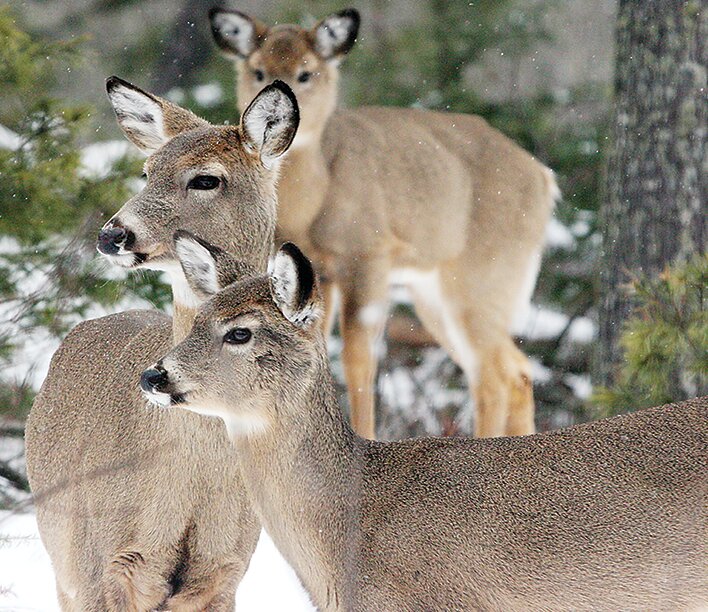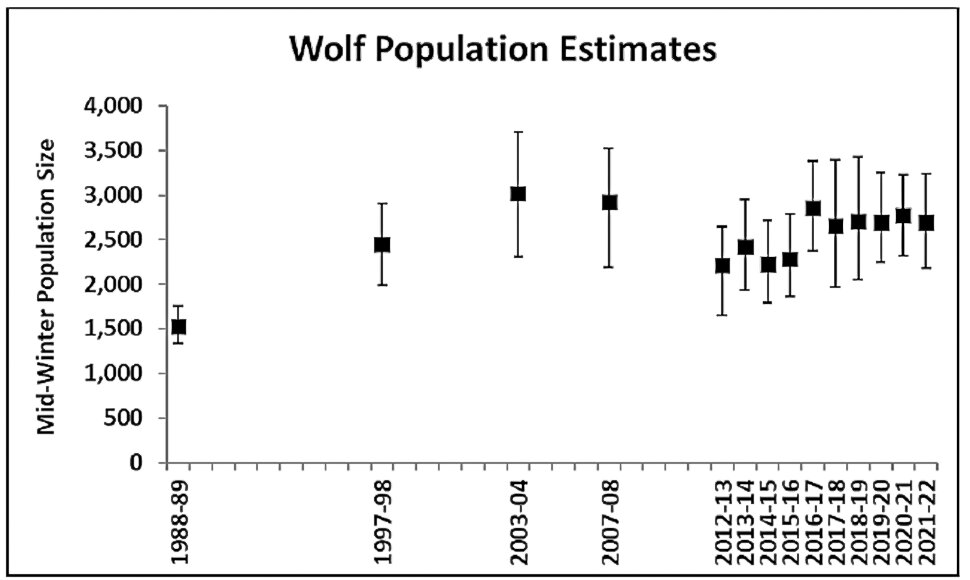Support the Timberjay by making a donation.
Deer registrations continue long decline
This year’s numbers correlate well with the drop in antlerless tags and winter severity
REGIONAL— Preliminary deer registrations continue to run below last year across all of northeastern Minnesota. The regular firearms deer season ended in the region back on Nov. 19, so the …
This item is available in full to subscribers.
Attention subscribers
To continue reading, you will need to either log in to your subscriber account, or purchase a new subscription.
If you are a current print subscriber, you can set up a free website account and connect your subscription to it by clicking here.
If you are a digital subscriber with an active, online-only subscription then you already have an account here. Just reset your password if you've not yet logged in to your account on this new site.
Otherwise, click here to view your options for subscribing.
Please log in to continue |
Deer registrations continue long decline
This year’s numbers correlate well with the drop in antlerless tags and winter severity
REGIONAL— Preliminary deer registrations continue to run below last year across all of northeastern Minnesota. The regular firearms deer season ended in the region back on Nov. 19, so the numbers currently available from the Department of Natural Resources should reflect something close to the final figures for the 2023 season.
The muzzleloader season runs through Dec. 10 in northeastern Minnesota, which could add marginally to the final totals.
The continuing decline in hunter success has put the focus on the impact of wolf predation on deer numbers, at least in conversations with hunters. Biologists with the DNR continue to cite winter severity as the biggest factor impacting deer numbers and hunter success.
While wolves are a key predator of white-tailed deer, the pattern of hunter success this year appears to correlate strongly with two primary factors— the number of antlerless permits issued by the DNR and the impact of winter, as measured through the winter severity index, or WSI.
Among the eight deer permit areas regularly tracked by the Timberjay, the decline in antlerless permits clearly account for most of the drop in registrations, particularly in PAs 176, 177, and 178, which typically see the highest registrations in the local area. “We cut the antlerless permits in those areas by 50 percent across the board,” noted DNR Tower area wildlife manager Jessica Holmes. “That is absolutely a factor,” she said. For example, so far in 2023, hunters in PA 177 have registered 137 antlerless deer, as opposed to 228 last year. That accounts for 92 percent of the registration decline this year over last. In PA 176, antlerless registrations are off by 49, accounting for 31 percent of the decline in registrations this year, while the drop in doe tags accounts for 50 percent of the registration decline in PA 178.
Winter weather also had an impact. While the last two winters have been generally considered severe due mostly to deep and dense snowpack, the track of winter storms varies from year-to-year, meaning that deer in some areas are harder hit than in others. Last winter, the deepest snows fell along the North Shore of Lake Superior in Cook, southern Lake, southern St. Louis and Carlton counties, and deer registrations in those areas showed some of the steepest declines in the region. Permit areas 183 and 156, both in Carlton County, saw deer registrations fall 39 and 40 percent respectively this year over last, based on preliminary totals in the wake of the regular firearms season. Reductions in deer numbers due to winter mortality and cuts in antlerless permits combined to account for most of that drop.
The seven northeastern Minnesota permit areas that experienced the highest WSI readings last winter saw a collective registration decline of 34 percent over last year and 44 percent over deer registrations in 2021.
By contrast, areas near the Canadian border, such as permit areas 107, 109, and 119, saw 2023 registrations increase slightly over last year. Permit area 118 was an exception, as registrations fell by about eight percent over last year, although the final numbers could well trim that margin slightly. These border areas saw significantly less snow last winter than permit areas to the south, which left conditions considered generally moderate throughout most of the those permit areas.
Registrations far lower than a decade ago
Even with the slight registration rebound in permit areas near the border this year, hunters are certainly correct in their perception that hunting success has fallen dramatically in much of the North Country when compared to results from a decade ago.
Back in 2012, hunters registered a whopping 4,649 deer in PA 178, compared to just 1,237 to date in 2023. Hunters in PA 177, which encompasses Lake Vermilion and farm country west of Cook, registered 1,451 deer in 2012, compared to 550 this year so far. Hunters in PA 176 registered 2,796 deer in 2012, compared to 566 this year to date, while hunters in PA 118 registered 697 deer in 2012 compared to 355 this year. PA 119, which used to attract large numbers of hunters to the western portion of the Superior National Forest northeast of Orr, saw 859 deer registered in 2012. While the 231 deer registered in that permit area so far this season reflect a slight increase over last year, it’s a drop of 73 percent from 2012 levels. Direct comparisons aren’t entirely accurate in all cases since the boundaries of some permit areas have changed somewhat over the years. In addition, the DNR typically implemented more liberal bag limits during periods of high deer numbers, which allowed hunters to take many more antlerless deer than has been the case in recent years.
Deer registrations, which ran historically high in the region in the 2000s and early 2010s, dropped sharply beginning in 2014, after back-to-back severe winters with deep snow that lasted into late April or early May.
By the 2014 deer season, with bag limits similar to recent years, deer registrations plummeted. In PA 177, registrations dropped to just 556, an almost identical number to this year. Hunters in PA 178 registered 1,190 deer, less than a quarter of the deer registered just two years earlier. Registrations in PA 119 fell from 859 in 2012 to just 330 in 2014.
While deer have the capacity to recover quickly from setbacks like severe winters, Holmes noted that the recent trend has been for snowier, if somewhat milder, winters. While the WSI adds points for both temperature and snow depth criteria, Holmes notes that snow depth and the length of the period of deep snow are the biggest factors in deer winter survival. “Eight of the last ten winters have been high-moderate to severe,” she said, noting that deer recovery has not been possible, with or without wolves. “We just can’t get a break, weather-wise,” she said.
DNR surveys
suggest stable wolf population
While many in the region have laid the blame for the declining deer population on wolves, it is worth noting that the historically high deer numbers and harvest experienced during the 2000s and early 2010s coincided with a wolf population in the region that was largely in line, if not higher, than today. According to the DNR, the wolf population in northeastern Minnesota has been essentially at carrying capacity for the past couple decades, and that carrying capacity would be expected to decline along with deer numbers based on well-accepted ecological principles.
Based on DNR wolf surveys, the state’s wolf population appears to have peaked at just under 3,000 animals in 2003-2004, during a period of high deer numbers, and has fallen about ten percent since. The most recent estimate of the state’s wolf population, made in 2021-22 came in at just under 2,700.









